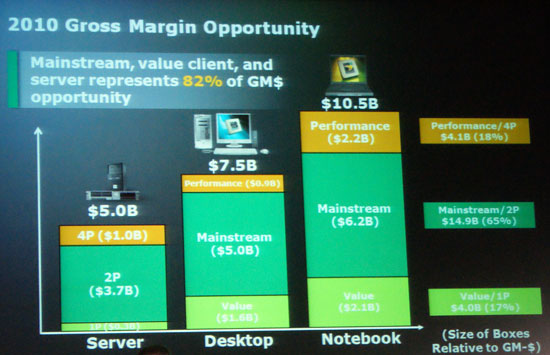The RV770 Story: Documenting ATI's Road to Success
by Anand Lal Shimpi on December 2, 2008 12:00 AM EST- Posted in
- GPUs
Building a GPU for the Masses
AMD put up this graph at its recent Financial Analyst Day:

The performance segment of the desktop CPU market is only about 7% of the pie and although it generates a disproportionately large amount of revenue it’s neither the biggest segment nor the biggest revenue generator in the market. That would be the mainstream segment.
ATI realized much of the same thing back in 2005. These high end GPUs were getting more and more expensive, while R300 tipped the scales at $399 over the coming years we’d see GPUs hit $499, $599 and go north of $600 at launch. The higher prices were due to increasing die sizes and techniques such as harvesting, ensuring that regardless of how big the GPU, revenues were protected.
A $399 R300 was close enough to the mainstream price points that ATI was able to scale it down months later to address other markets, but these days the time between the high end GPU introduction and the mainstream revisions of it has increased to 6 - 9 months. We still don’t have a mainstream derivative of NVIDIA’s GT200 architecture and chances are that we won’t until around 9 months after its introduction. With the GeForce GTX 280 launching at $600, for it to take 9 months to make a $200 derivative is doing the market a disservice in ATI’s eyes.
It was time to refocus. Instead of tailoring to the needs of the high end, ATI wanted to make a product that would be the best in the $200 - $300 range. To do so would mean that it would have to reverse the strategy that made it successful to begin with, and hope that somehow NVIDIA wouldn’t follow suit.










116 Comments
View All Comments
yourwhiteshadow - Thursday, December 4, 2008 - link
absolutely brilliant. i've always read anandtech instead of tomshardware because of objective reviews. i was reading an intel review, and people were questioning the objectivity of anandtech. while some might could look at this as praising ATI/AMD, i would definitely say this was a very objective view of what happened. seriously, one of the BEST articles i've read since the 4850/4870 review.kevyeoh - Thursday, December 4, 2008 - link
I've been reading anandtech for years and there wasn't any article that makes me wanna read every single word of it. Usually i will read the forewords and then skip on to the Conclusion. But for this article, i really read every single words! period! Anandtech rocks!nitemareglitch - Thursday, December 4, 2008 - link
I was actually getting a little bored with the articles around here, until I read this one. Great job, I loved reading this story!!lchyi - Thursday, December 4, 2008 - link
This is by far the best (and most insightful) article I have read here to date Anand. It sounds like you put in a ton of thought to it and I have never flown through 7,500 words as quick as that read. Congrats to the ATI guys for their successful gamble on the RV770. The last three years must have been an extremely interesting experience for them and their engineers.joshjnm - Thursday, December 4, 2008 - link
Great article I will bandwagon with the rest of you and agree this is one of the best articles I've read in a while.josh6079 - Thursday, December 4, 2008 - link
I thoroughly enjoyed the article. Last time I was really involved with graphics cards was when the X1900's were in full swing and G80 was on everyone's mind. The history told in the article helped bring me up to pace as to what has transpired since I stopped gaming as much. I can remember how the Video card section used to be here on the forums with the trolls and constant flames. Two camps of people cheered on for one or the other competitors instead of realizing that they should be cheering for competition itself.Great job ATI, Nvidia - what's next?
Seikent - Thursday, December 4, 2008 - link
Very good article, most of these interesting background stories are written in books, but a lot of years latter.Something, that is not mentioned, is that it seems that AMD didn't affect ATI in any way (technically speaking). Many thought that the R600 failure had something to do with AMD.
BSMonitor - Thursday, December 4, 2008 - link
Awesome article.I am definately a performance/mainstream kinda guy in this market. Definately love the competition. I started my first build with a Geforce 4200Ti, moved up to the infamous 9700Pro, followed by X1900, and now 4850HD...
It is good to see that the ATI/AMD didn't damage ATI as a whole. Rock on guys! Love those cheap kick ass Crossfire cards! Go 4850HD x2.
dmer - Thursday, December 4, 2008 - link
as a long time reader of anand I never felt the need to register an account; however, after reading your article I felt compelled to create an account just to commend you on an excellent article.we need more articles that give us insight into business decisions like this. job well done mate!
johnkwright - Thursday, December 4, 2008 - link
Anand,I've been a long time reader of AnandTech but I especially liked this article. It was interesting to get a peek behind the curtain to see what challenges companies face when making these tough decisions. Hopefully more companies take a chance and share more of their stories with this site. Keep up the good work.
Regards,
John Wright